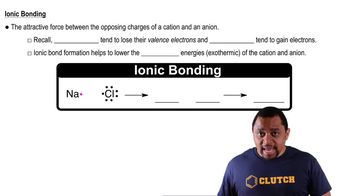Textbook Question
Predict the chemical formula of the ionic compound formed between the following pairs of elements: (b) K and S
 Verified step by step guidance
Verified step by step guidance



Predict the chemical formula of the ionic compound formed between the following pairs of elements: (b) K and S
Predict the chemical formula of the ionic compound formed between the following pairs of elements: (d) Mg and N
Which ionic compound is expected to form from combining the following pairs of elements? (d) aluminum and oxygen.
Write the electron configuration for each of the following ions, and determine which ones possess noble-gas configurations: a. Rb+ b. Rh3+ c. P3− d. Sc3+ e. S2− f. V2+.
(b) Write the chemical equation that represents the process of lattice energy for the case of NaCl.